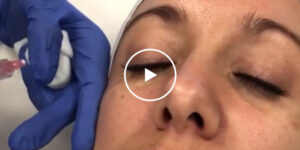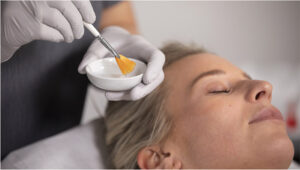Free radicals and vitamin C are hot topics at the moment, especially when it comes to offering skincare advice.
Magazines are filled with recipes for high-antioxidant smoothies to clear your complexion and lists of free radical–fighting superfoods to make your skin sparkle. But many of these articles and posts overlook a crucial point: when it comes to guarding the skin against sun damage and free radicals, topical vitamin C is more effective than any smoothie or supplement. In this guide to vitamin C, free radicals and photoageing, we reveal how to use antioxidants to protect your skin from the sun.
While eating a balanced diet is important for your overall health, dermatological researchdemonstrates that the body’s absorption of vitamin C is limited when it’s consumed through food or supplements. This is why dermatologists and aesthetic doctors favour topical vitamin C applications; applying vitamin C directly onto the skin delivers the antioxidant straight to the area that needs it most. (You can still drink your superfood smoothie, just don’t rely on it for skincare.)
How do free radicals and topical vitamin C work?
When the skin is exposed to sunlight, the sun’s ultraviolet rays produce free radicals that penetrate the skin. These free radicals are then able to damage cells and destroy collagen, the protein that is responsible for keeping the skin firm and supple. Over time, this breakdown of collagen can contribute to the appearance of ageing skin with wrinkles and fine lines.
However, when topical vitamin C is applied, it is absorbed directly into the skin, where it neutralises the free radicals that are produced during sun exposure. It also supports the production of collagen, preventing the onset of signs of skin ageing.
Prevent ageing in your skin
Studies suggest that the most effective concentrations of topical vitamin C for skin anti-ageing are within the range of five to fifteen percent, and that a combination of vitamins C and E is even more powerful than the topical application of either antioxidant by itself. When it comes to antioxidants, there is strength in numbers.
And what about sunscreen? Any article on skincare advice would be remiss if it did not stress the importance of SPF. But sunscreen prevents only part of the damage that comes from UV exposure—just 55% of UV-induced free radicals. Keep applying sunscreen as a part of your daily skincare routine, but combine it with topical vitamin C and vitamin E to maximise your protection.
As with every aspect of skincare, topical vitamin C products are not one-size-fits-all. The experienced aesthetic doctors at WY can help determine the right type of topical vitamin C for you, and the best methods of treating sun damaged skin. During your initial consultation, we use a computerised Visia skin analysis, to look at the effects of sun damage on your skin—we are even able to see brown spots and hyperpigmentation that are not yet visible on the skin’s surface. This analysis allows us to create a treatment plan bespoke to you that is both preventative and corrective—one that will ultimately give your skin a rejuvenated glow that no smoothie could provide.
Finding and applying a topical vitamin C product that suits your skin is one of the most effective steps you can take in preventing photoaging. Book an appointment with the team at Waterhouse Young today to start on the path towards healthier, younger-looking skin.






